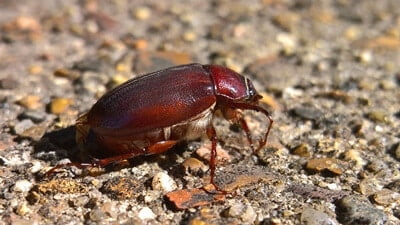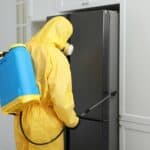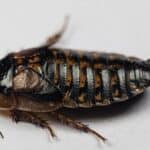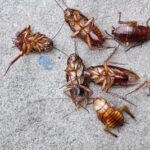If you notice a cockroach outside your house, you may be worried that you have cockroaches inside your house, too. Infestations are hard to treat because they breed and multiply so quickly. However, cockroaches outside aren’t always an indication that you have an infestation, although you must exercise caution.
If you see a cockroach outside, you don’t necessarily have an infestation. German cockroaches are most likely to move into homes because they don’t survive outside during cold winters. Other cockroaches, such as the American and Oriental, are far happier to live outside throughout the seasons.
All cockroach species need food, water, warmth, and shelter. They get these by living in tree trunks, mulch, leaf and woodpiles, shrubs and flowerbeds, compost heaps, and garbage bins. The moment cockroaches don’t have the resources they need, they’ll look for them elsewhere. This is when your home becomes vulnerable.
Where Do Roaches Live Outside?
Many cockroaches prefer to live outside than in homes. Regardless of the species, cockroaches live in warm places that offer protection from predators and access to food and water. Many cockroaches also dislike artificial light, so outdoor environments replicate natural conditions and enable roaches to hide away until it gets dark.
Cockroaches also tend to congregate together in large colonies, even when they’re outside. They do this by using several communication methods, such as:
- Pheromones: According to the Chemistry of Pheromones and Other Sociochemicals, cockroaches use pheromones to command one another to do things.
- Aggregation Pheromones: These are a type of chemical made up of poop, fatty acids, and skin that cockroaches use to get each other to assemble in one specific area.
- Stridulation: Cockroaches rub their wings and legs together to create friction, making a soft sound that other cockroaches can hear. They also make a soft chirp by opening and closing holes in their exoskeleton.
When cockroaches are outside, they live amongst or underneath materials that provide them with the protection and warmth they need to survive. They rarely live anywhere out in the open, as this would leave them vulnerable to predators. Nevertheless, there are many places they will live outside, including:
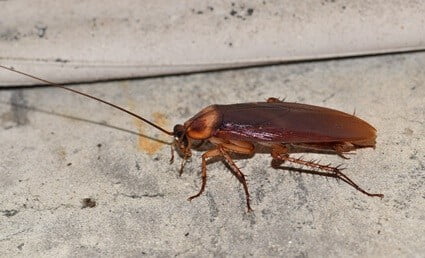
Tree Trunks
Rotting tree trunks are a great place for cockroaches to live. Not only are they warm and damp, but the decaying wood provides them with the food and sustenance they need.
Shrubs and Flowerbeds
Cockroaches also live in shrubs and flowerbeds. They’re not attracted to flowers and plants but the warmth, moisture, and shelter that soil provides. However, some roaches eat decaying plants and leaves, so living near shrubs and flowerbeds sometimes provides an essential source of food and water, enabling cockroaches to thrive. You can get rid of cockroaches in shrubs and flowerbeds with:
- Diatomaceous earth
- Baking soda traps
- Sticky traps
- Submerging the roaches in water
Leaf and Wood Piles
Leaf and woodpiles are both suitable homes for cockroaches to live in. Oriental cockroaches, in particular, enjoy living amongst leaves, wood, and mulch where it’s moist and dark. American cockroaches are also known to live in woodpiles. If you keep leaves and wood close to the boundaries of your home, there’s a chance cockroaches could move into your home to find warmth when it starts to get cold.
Cockroaches also enjoy living amongst bark and pine straw mulch. Both materials are lightweight, enabling roaches to burrow deep. Decaying bark mulch is also a good source of food and energy.
Compost Piles
As described by Biotropica, cockroaches are detritivore-herbivore insects. This means they eat many different kinds of decaying food – many of which are placed in compost piles, such as:
- Meat
- Decaying fruit and veg
- Food scraps, such as avocado skins and potato peel and
- Grass clippings and leaves
- Newspaper
These things are some of a cockroach’s favorite foods, and living in a compost pile gives them plenty to feed off. While you might want to keep cockroaches out of your compost pile, they can benefit the decomposition process. Not only do cockroaches decompose when they die, but they break down trash as they eat it, turning it into reusable matter.
Garbage
Garbage cans contain many of the same decaying foods as compost piles, including grease spills, rotting fruits and vegetables, and meat carcasses. Alongside sugary, starchy foods, these are some of a cockroach’s favorite things to eat.
Cockroaches can also chew through flimsy plastic bin bags to get to the food due to their strong mandibles (jaws). This means garbage cans are breeding grounds for cockroaches and their nymphs.
Sewers and Drains
Cockroaches, especially Oriental and American cockroaches, live in underground drains and sewer systems. There’s plenty of moisture in drains and sewers, and cockroaches remain safe from predators when inside them. Pipes are also insulating, keeping cockroaches protected from freezing temperatures in winter and hot temperatures in summer.
Not only that, but drains and sewers give cockroaches access to indoor environments should they wish to leave the outdoors. This is why some cockroaches end up in bathrooms.
Should I Be Worried If I See A Cockroach Outside My House?
Before you worry that you have cockroaches in your house, you should first identify the species. If you see a German cockroach in your yard, there’s a chance that you have an infestation inside the home. That’s because, as we’ve mentioned, German cockroaches are common house invaders that can’t live outside in the cold.
Other cockroach species are less likely to have gotten inside your home as they’re happier to live outside. Cockroaches have no reason to move inside as long as there’s warmth, shelter, food, and water outside.
The risk of a home invasion increases when there are no resources outdoors but plenty inside your home. When this happens, cockroaches are forced to search elsewhere for the things they need. If you’re concerned about a cockroach you’ve seen outside, look for signs of an infestation. These include:
- Musty odor
- Small droppings that look like coffee granules
- Shed exoskeletons
- Brown smears
- Bite marks and damage to furniture
- Cockroaches themselves
These are tell-tale signs that cockroaches have moved into your home from the yard. As a result, you’ll need to act fast to remove them and protect your belongings. If you don’t notice any of these things, it’s likely the cockroaches you saw are confined to the yard for the time being. So, take measures to prevent them from migrating inside.
Why Do Outside Roaches Come Inside?
As mentioned, many cockroaches prefer to live outside and rarely invade homes. That’s because many outdoor environments are safer and provide them with everything they need to survive.
However, domestic cockroaches, including German cockroaches, can’t survive cold winters outside. As a result, they’ve adapted to living around people. Once they get into the home, they become a significant nuisance and invade small areas that are hard to reach.
On the other hand, cockroaches that live both inside and out can reproduce indoors and outdoors. They are known as “peridomestic.” Such species include:
Because cockroaches are so used to living outside, you might be wondering what attracts roaches inside. They’ll leave their homes if they don’t have:
- Food
- Water
- Warmth
- Shelter
Another thing is that once cockroach colonies become too large through breeding, they run out of space and need to find other places to live to prevent competition for food and other resources.
Cockroaches that don’t move indoors when it gets cold hunker down somewhere safe and become almost inactive until it warms up.
How Do Cockroaches Get Inside?
Depending on where cockroaches choose to live when they’re outside, they can get into homes through:
- Pipes
- Drainage systems
- Cracks in mortar
- Vents in house foundations
- Brick weep holes
- Gaps around doors
- Open windows
Wood cockroaches are slightly more unique. They don’t intend to move inside, but they’re sometimes attracted to bright outdoor lights. As a result, they unwittingly wander into homes through gaps and holes. They’re also carried into homes through flowerpots and firewood.
However, wood cockroaches don’t like being inside and commonly die shortly after moving in. Females are more likely to hide in dark, damp corners, but this doesn’t mean you have an infestation.
How To Prevent Cockroaches Going Inside
Even though cockroaches aren’t guaranteed to move inside your home if they’re already in your yard, it’s best not to take the risk. There are measures you can take to prevent them from going inside your home, such as:
Seal Entry Points
This involves covering gaps underneath doors, keeping windows shut, and ensuring cockroaches can’t get in through drains and pipes. Be sure to seal up cracks with caulk to make them impenetrable to cockroaches.
Roaches can squeeze into the smallest gaps, so you must fill all holes, as they’re likely to fit through them.
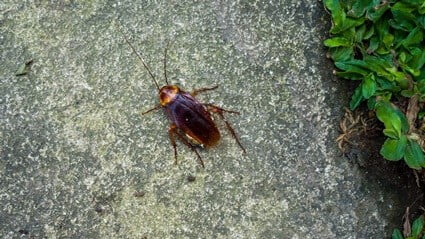
Choose Mulch Cockroaches Hate
We’ve determined that cockroaches live in bark and pine straw mulch. Keeping these materials close to your home invites them to make your yard their home – which is also one step away from a home invasion. Instead, choose mulch cockroaches are repelled by. There are several to choose from, such as:
- Cedar
- Cypress
- Plastic
- Rubber
- Cocoa bean shell
- Sugar cane
- Tea tree
You’ll also want to spread your mulch thin – no thicker than 3-4 inches – and keep it at least 12 inches from the foundations of your home. Keeping cockroaches away from your home is far easier than getting rid of them once they’re inside.
Use Natural Repellents
While repellents won’t necessarily keep cockroaches from entering your home, they can prevent them from staying there too long. There are several natural remedies cockroaches hate the smell of, including:
- Catnip
- Coffee
- Peppermint
- Eucalyptus
- Lemon
- Cedarwood
- Cypress
- Rosemary
- Oregano
- Bay leaves
Brewing tea using these ingredients or sprinkling them over the entry points of your home may warn cockroaches away and keep them outside as a result.
Keep Your Yard Tidy
Keeping your yard clean, tidy, and free of debris helps to keep cockroaches away from it altogether. The result is that they won’t attempt to move into your home. Remove all woodpiles and dead leaves before cockroaches make these areas their home. You should also keep wood at least one foot away from your house. Other measures to take include:
- Cut all tall grasses and overgrown bushes
- Fill in tree holes with cement
- Keep trash cans covered with a secure lid
- Maintain plants and shrubbery and don’t overwater them
These steps will help keep cockroach populations under control, reducing the risk of them entering your home.
Cockroaches outside don’t always mean cockroaches inside. Whether you experience an infestation or not all comes down to the resources available to cockroaches outside, how easy it is to get inside your home, and whether your house has everything cockroaches need to survive.
